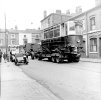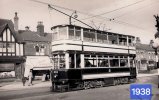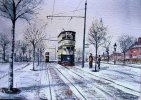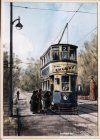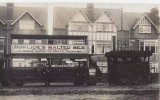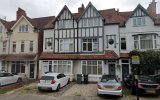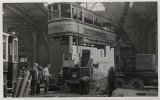-
Welcome to this forum . We are a worldwide group with a common interest in Birmingham and its history. While here, please follow a few simple rules. We ask that you respect other members, thank those who have helped you and please keep your contributions on-topic with the thread.
We do hope you enjoy your visit. BHF Admin Team
You are using an out of date browser. It may not display this or other websites correctly.
You should upgrade or use an alternative browser.
You should upgrade or use an alternative browser.
Birmingham Trams
- Thread starter tardebigge
- Start date
paul stacey
master brummie
Great Pic Viv, I remember the trams really well, and the noises they made. Older view looks more friendly and cleaner!!
Richard Dye
master brummie
Absolutely looks much nicer and certainly clean!Great Pic Viv, I remember the trams really well, and the noises they made. Older view looks more friendly and cleaner!!
Radiorails
master brummie
Car 634 was the Oxhill Road terminus of route 26. Abandoned in April 1939 and replaced by bus route 70.
Richard Dye
master brummie
Oxill Rd 70, that is a blast from the past! Took that bus SO many times.Car 634 was the Oxhill Road terminus of route 26. Abandoned in April 1939 and replaced by bus route 70.
bordesley bob
knowlegable brummie
Someone on a local site (Telford) has 30 photos of Birmingham Trams that they don't want to throw away, who can I get them sent to? Apparently they tried two museums who weren't interested.
Someone on a local site (Telford) has 30 photos of Birmingham Trams that they don't want to throw away, who can I get them sent to? Apparently they tried two museums who weren't interested.
have they tried here..there is a tel number ..do you know if they are actual photographs taken or prints
Home | Aldridge Transport Museum
Aldridge Transport Museum, displaying the legacy of road transport in the West Midlands. Formerly Aston Manor Road Transport Museum
bordesley bob
knowlegable brummie
Thanks I passed that onhave they tried here..there is a tel number ..do you know if they are actual photographs taken or prints
Home | Aldridge Transport Museum
Aldridge Transport Museum, displaying the legacy of road transport in the West Midlands. Formerly Aston Manor Road Transport Museumwww.amrtm.org
Lloyd
master brummie
The best archive for tram photos is:
The National Tramway Museum
Crich Tramway Village, nr Matlock,
Derbyshire, DE4 5DP
[email protected]
Telephone: 01773 854 321
Much of their photo archive is viewable online at https://www.tramway.co.uk/library-collections/photographic-collection/
The National Tramway Museum
Crich Tramway Village, nr Matlock,
Derbyshire, DE4 5DP
[email protected]
Telephone: 01773 854 321
Much of their photo archive is viewable online at https://www.tramway.co.uk/library-collections/photographic-collection/
cookie273uk
master brummie
Richard Dye
master brummie
Great work Eric, your style of painting is wonderful!trams where one of my favourite painting subjects, exhibited and sold many, Eric
Radiorails
master brummie
The Washwood Heath single deck cars were a short lived experiment by BCT The cars shown were ex company cars (CBT) and carried BCT numbers 451 and 509. 451 was one or two of the longest cars operated by BCT and was given a top cover in 1924. 509 was converted to a maintenance car in December 1928.
BrummieGeoff
Sparkhill Lad
devonjim
master brummie
There was a single deck car operating through Camp Hill in the last days of trams in mid 1950's. Always took it to being used to transport BCT staff, it was long after public routes had ceased.The Washwood Heath single deck cars were a short lived experiment by BCT The cars shown were ex company cars (CBT) and carried BCT numbers 451 and 509. 451 was one or two of the longest cars operated by BCT and was given a top cover in 1924. 509 was converted to a maintenance car in December 1928.
Lloyd
master brummie
This would be works car PW8, cut down from double decker 266. It was the last operable tram on the system, and the last to be taken away for scrap as it shunted the others into the scrap line at Kyotts Lake Road works. Here it is at Witton; and finally on the scrapman's lorry off to Stratford on Avon where his yard was.There was a single deck car operating through Camp Hill in the last days of trams in mid 1950's. Always took it to being used to transport BCT staff, it was long after public routes had ceased.
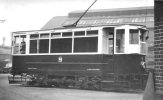
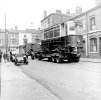
Richard Dye
master brummie
Certainly looks like it could be!
Lloyd
master brummie
Yes, the top deck was cut off, then the lower deck was lifted off its bogies and put onto a low-loader lorry, then the bogies were put into the lower deck and the top deck placed on top. This was necessary as the route to the scrapyard in Stratford on Avon had a low bridge en route. The single decker on the left was a 'works car', PW8, cut down from a double decker years earlier, and was used to shunt the trmas around in the place illustrated, Kyotts Lake Road tram repair works and was the last car to leave, not needing to be cut down like the others. It is seen below off on its final journey.
